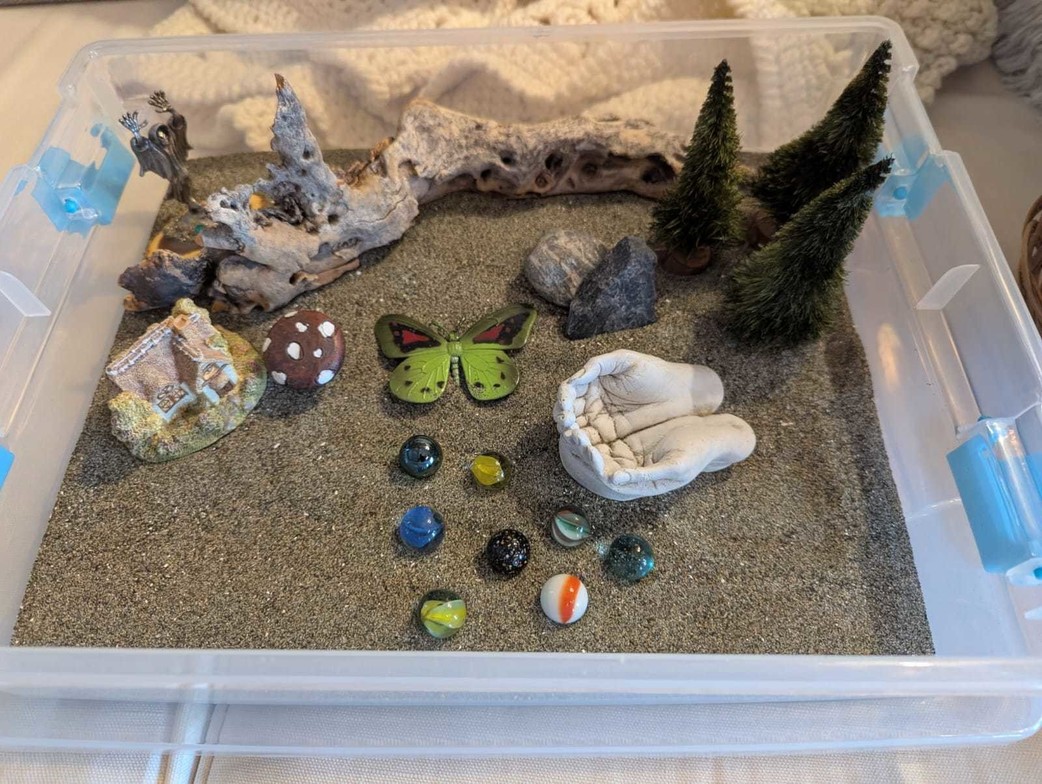
When words aren’t enough to express what’s going on inside, sandtray therapy offers another way to communicate. Sandtray invites clients to explore their inner world by creating miniature “scenes” in the sand using small figures and objects. On the surface it looks simple, but it is profoundly healing.
What is Sandtray Therapy?
Sandtray is a hands-on, experiential, expressive therapy that is a little bit like a blend between play therapy and art therapy. During a sandtray session, a client will pick out various figurines, toys, water, or natural materials to build a scene inside a tray filled with sand. The therapist might prompt a client to build a certain scene (e.x., do a sandtray on loneliness) or more broadly
invite the client to “create a world” in the sand. The sandtray then becomes a mirror for the client’s inner world. Using gentle questions and guidance, a therapist supports their client to explore and process the scene they created. This helps to uncover insights and emotions that may have been hidden or hard to express through just talking. Often my clients are surprised by what comes out in the sandtray!
How Sandtray Therapy Works
Sandtray uses what we call a “bottom up” approach, meaning it bypasses the logical, analyzing parts of us and creates healing changes deep in the brain. Although I might ask my clients gentle questions about the tray they made, it really doesn’t require words or verbal processing to see changes. Occasionally we’ll simply sit with the tray and what it represents – which is just
as beneficial – because the beautiful internal work of sandtray is in the process of creating. By externalizing their internal world into the sandtray, clients can observe themselves and their problems from a new point of view. It’s a creative counselling process that is deeply personal and integrates sensory, emotional, and cognitive processing.
Who Can Benefit from Sandtray Therapy
Many of my sandtray clients are children, but I will say that it isn’t just for children – it can be very helpful for teens and even adults to work creatively with images too. This can be particularly helpful for adults who tend to overanalyze, who like to express themselves creatively, or who find that no matter how much they talk about the problem, it still seems to be there. Sandtray also helps with many specific issues such as:
- neurodivergence, such as ADHD or Autism (my neurodivergent clients LOVE doing regulatingmovements with the sand - many find they're able to self-soothe simply through the sensory experience)
- depression
- anxiety
- trauma
- grief and loss-learning difficulties
Experience the Healing Power of Sandtray
Whether you or your child have experienced a trauma, a loss, navigating life changes, or simple seeking new ways to understand yourself, sandtray therapy offers a safe and creative option for healing.
If you’re curious about how Sandtray Therapy can support you or your child’s healing journey, I’d love to help. Book a session or reach out today to learn more about how creative, experiential approaches can help you or your child feel more grounded and connected.



